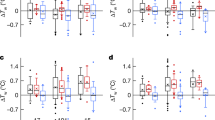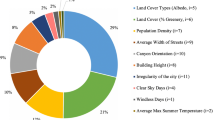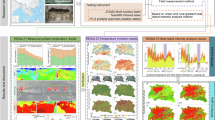Abstract
Urban environments are usually hotter than their rural surroundings, a phenomenon known as the urban heat island (UHI) effect. The mean UHI effect implies that urban environments would experience more heat events if the same temperature threshold is used to identify heat events in both urban and rural environments. However, the role of higher-order temperature statistics, such as temperature variance and persistence, in determining urban–rural differences of heat event occurrence remains elusive. Here, using numerical simulations from two global models, we demonstrate that up to 94% of urban–rural differences in hot day occurrence are driven by the mean UHI effects normalized by temperature variance, that is, the standardized mean UHI effects. For multi-day heat events, temperature persistence further plays an important role. These findings reveal how the temperature mean, variance and persistence interact to determine the urban–rural difference in heat event occurrence. Cities with more pronounced standardized mean UHI effects and enhanced temperature persistence should place greater emphasis on mitigating the adverse impacts caused by extreme heat.
This is a preview of subscription content, access via your institution
Access options
Subscribe to this journal
Receive 12 digital issues and online access to articles
$119.00 per year
only $9.92 per issue
Buy this article
- Purchase on SpringerLink
- Instant access to full article PDF
Prices may be subject to local taxes which are calculated during checkout




Similar content being viewed by others
Data availability
Data generated in this study are available on Zenodo at https://doi.org/10.5281/zenodo.15131945 (ref. 34) and are publicly accessible.
Code availability
Analysis code used in this study is available on Zenodo at https://doi.org/10.5281/zenodo.15131945 (ref. 34). MATLAB R2022b is used to analyze the data.
References
Meehl, G. A. & Tebaldi, C. More intense, more frequent, and longer lasting heat waves in the 21st century. Science 305, 994–997 (2004).
Frölicher, T. L., Fischer, E. M. & Gruber, N. Marine heatwaves under global warming. Nature 560, 360–364 (2018).
Wang, J. et al. Anthropogenically-driven increases in the risks of summertime compound hot extremes. Nat. Commun. 11, 528 (2020).
Pfleiderer, P., Schleussner, C.-F., Kornhuber, K. & Coumou, D. Summer weather becomes more persistent in a 2 °C world. Nat. Clim. Change 9, 666–671 (2019).
Sun, Y. et al. Rapid increase in the risk of extreme summer heat in Eastern China. Nat. Clim. Change 4, 1082–1085 (2014).
Li, J. & Thompson, D. W. J. Widespread changes in surface temperature persistence under climate change. Nature 599, 425–430 (2021).
Simolo, C. & Corti, S. Quantifying the role of variability in future intensification of heat extremes. Nat. Commun. 13, 7930 (2022).
Chan, D., Cobb, A., Zeppetello, L. R. V., Battisti, D. S. & Huybers, P. Summertime temperature variability increases with local warming in midlatitude regions. Geophys. Res. Lett. 47, e2020GL087624 (2020).
Mearns, L. O., Katz, R. W. & Schneider, S. H. Extreme high-temperature events: changes in their probabilities with changes in mean temperature. J. Appl. Meteorol. Climatol. 23, 1601–1613 (1984).
Barnston, A. G., Lyon, B., Coffel, E. D. & Horton, R. M. Daily autocorrelation and mean temperature/moisture rise as determining factors for future heat-wave patterns in the United States. J. Appl. Meteorol. Climatol. 59, 1735–1754 (2020).
Li, D. et al. Persistent urban heat. Sci. Adv. 10, eadj7398 (2024).
Kalnay, E. & Cai, M. Impact of urbanization and land-use change on climate. Nature 423, 528–531 (2003).
Sun, Y., Zhang, X., Ren, G., Zwiers, F. W. & Hu, T. Contribution of urbanization to warming in China. Nat. Clim. Change 6, 706–709 (2016).
Manoli, G. et al. Magnitude of urban heat islands largely explained by climate and population. Nature 573, 55–60 (2019).
Zhao, L., Lee, X., Smith, R. B. & Oleson, K. Strong contributions of local background climate to urban heat islands. Nature 511, 216–219 (2014).
Zhou, L. et al. Evidence for a significant urbanization effect on climate in China. Proc. Natl. Acad. Sci. USA 101, 9540–9544 (2004).
Zhao, L. et al. Global multi-model projections of local urban climates. Nat. Clim. Change 11, 152–157 (2021).
Domeisen, D. I. V. et al. Prediction and projection of heatwaves. Nat. Rev. Earth Environ. 4, 36–50 (2023).
Liao, W. et al. Stronger contributions of urbanization to heat wave trends in wet climates. Geophys. Res. Lett. 45, 1131–1140 (2018).
Oleson, K. W., Bonan, G. B. & Feddema, J. Effects of white roofs on urban temperature in a global climate model. Geophys. Res. Lett. 37, L03701 (2010).
Wang, L., Huang, M. & Li, D. Where are white roofs more effective in cooling the surface? Geophys. Res. Lett. 47, e2020GL087853 (2020).
Seneviratne, S. I. et al. Investigating soil moisture–climate interactions in a changing climate: a review. Earth Sci. Rev. 99, 125–161 (2010).
Trewin, B. Exposure, instrumentation, and observing practice effects on land temperature measurements. WIREs Climate Change 1, 490–506 (2010).
Chan, D., Gebbie, G. & Huybers, P. An improved ensemble of land surface air temperatures since 1880 using revised pair-wise homogenization algorithms accounting for autocorrelation. J. Clim. 37, 2325–2345 (2024).
Zhao, M. et al. The GFDL global atmosphere and land model AM4.0/LM4.0: 2. Model description, sensitivity studies, and tuning strategies. J. Adv. Model. Earth Syst. 10, 735–769 (2018).
Li, D., Malyshev, S. & Shevliakova, E. Exploring historical and future urban climate in the Earth System Modeling framework: 1. Model development and evaluation. J. Adv. Model. Earth Syst. 8, 917–935 (2016).
Li, D., Malyshev, S. & Shevliakova, E. Exploring historical and future urban climate in the Earth System Modeling framework: 2. Impact of urban land use over the Continental United States. J. Adv. Model. Earth Syst. 8, 936–953 (2016).
Lawrence, D. M. et al. The Community Land Model version 5: description of new features, benchmarking, and impact of forcing uncertainty. J. Adv. Model. Earth Syst. 11, 4245–4287 (2019).
Danabasoglu, G. et al. The Community Earth System Model version 2 (CESM2). J. Adv. Model. Earth Syst. 12, e2019MS001916 (2020).
Sheffield, J., Goteti, G. & Wood, E. F. Development of a 50-year high-resolution global dataset of meteorological forcings for land surface modeling. J. Clim. 19, 3088–3111 (2006).
Liao, W. et al. Amplified increases of compound hot extremes over urban land in China. Geophys. Res. Lett. 48, e2020GL091252 (2021).
Oleson, K. W. & Feddema, J. Parameterization and surface data improvements and new capabilities for the Community Land Model Urban (CLMU). J. Adv. Model. Earth Syst. 12, e2018MS001586 (2020).
Jackson, T. L., Feddema, J. J., Oleson, K. W., Bonan, G. B. & Bauer, J. T. Parameterization of urban characteristics for global climate modeling. Ann. Assoc. Am. Geogr. 100, 848–865 (2010).
Liao, W., Wang, L., Liu, X., Chan, D. & Li, D. Standardized heat islands and persistence drive modelled urban heat events—supporting data. Zenodo https://doi.org/10.5281/zenodo.15131945 (2025).
Acknowledgements
X.L. acknowledges support from the National Science Fund for Distinguished Young Scholars (grant no. 42225107). W.L. acknowledges support from the National Natural Science Foundation of China (grant no. 42271419), Innovation Group Project of Southern Marine Science and Engineering Guangdong Laboratory (Zhuhai) (grant no. 311021004), and Fundamental Research Funds for the Central Universities, Sun Yat-sen University (grant no. 23lgbj014). D.L. acknowledges support from the US Department of Energy, Office of Science, as part of research in MultiSector Dynamics, Earth and Environmental System Modeling Program.
Author information
Authors and Affiliations
Contributions
W.L. designed the study, carried out the analysis and wrote the paper. L.W. performed the simulations. X.L. designed and supervised the study. D.C. and D.L. designed the study and wrote the paper.
Corresponding authors
Ethics declarations
Competing interests
The authors declare no competing interests.
Peer review
Peer review information
Nature Cities thanks Matteo Zampieri and the other, anonymous, reviewer(s) for their contribution to the peer review of this work.
Additional information
Publisher’s note Springer Nature remains neutral with regard to jurisdictional claims in published maps and institutional affiliations.
Supplementary information
Supplementary Information
Supplementary Figs. 1–7.
Source data
Source Data Fig. 2
Statistical source data.
Source Data Fig. 3
Statistical source data.
Source Data Fig. 4
Statistical source data.
Rights and permissions
Springer Nature or its licensor (e.g. a society or other partner) holds exclusive rights to this article under a publishing agreement with the author(s) or other rightsholder(s); author self-archiving of the accepted manuscript version of this article is solely governed by the terms of such publishing agreement and applicable law.
About this article
Cite this article
Liao, W., Wang, L., Liu, X. et al. Standardized heat islands and persistence drive modeled urban heat events. Nat Cities 2, 857–864 (2025). https://doi.org/10.1038/s44284-025-00290-2
Received:
Accepted:
Published:
Issue date:
DOI: https://doi.org/10.1038/s44284-025-00290-2



